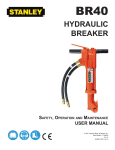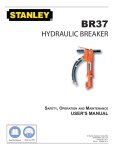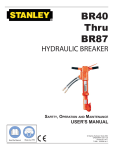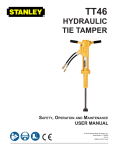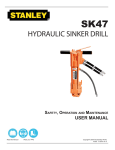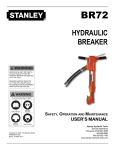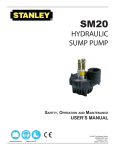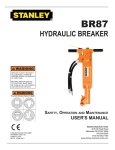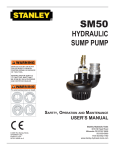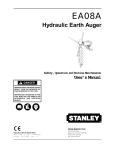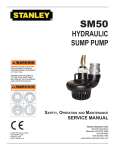Download BR40 User Manual 4-2009.indb
Transcript
BR40 HYDRAULIC BREAKER WARNING WARNING To avoid seriou s injury o r death SAFETY, OPERATION AND MAINTENANCE USER'S MANUAL © Stanley Hydraulic Tools 2004 OPS/MAINT USA / CE Printed in U.S.A. 62399 4/2009 ver 4 Stanley Hydraulic Tools 3810 SE Naef Road Milwaukie OR 97267-5698 503-659-5660 FAX 503-652-1780 www.stanleyhydraulic.com TABLE OF CONTENTS CERTIFICATE OF CONFORMITY............................................................................................................................. 4 SAFETY SYMBOLS................................................................................................................................................... 5 SAFETY PRECAUTIONS .......................................................................................................................................... 6 TOOL STICKERS & TAGS ........................................................................................................................................ 7 HYDRAULIC HOSE REQUIREMENTS ..................................................................................................................... 8 HTMA REQUIREMENTS ......................................................................................................................................... 10 OPERATION ............................................................................................................................................................ 11 PRE-OPERATION PROCEDURES ...................................................................................................................... 11 CHECK POWER SOURCE .................................................................................................................................. 11 INSTALL TOOL BIT............................................................................................................................................... 11 CONNECT HOSES............................................................................................................................................... 11 COLD WEATHER OPERATION ........................................................................................................................... 11 EQUIPMENT PROTECTION & CARE..................................................................................................................... 12 TROUBLESHOOTING ............................................................................................................................................. 13 CHARGING THE ACCUMULATOR ......................................................................................................................... 14 ACCUMULATOR TESTING PROCEDURE ......................................................................................................... 14 ACCUMULATOR CHARGING .............................................................................................................................. 14 SPECIFICATIONS ................................................................................................................................................... 16 ACCESSORIES ....................................................................................................................................................... 16 BR40 T-HANDLE PARTS ILLUSTRATION .............................................................................................................. 17 BR40 T-HANDLE PARTS LIST ................................................................................................................................ 18 BR40 ANTI-VIBRATION HANDLE PARTS ILLUSTRATION .................................................................................... 19 BR40 ANTI-VIBRATION HANDLE PARTS LIST ...................................................................................................... 20 WARRANTY............................................................................................................................................................. 21 SERVICING THE STANLEY HYDRAULIC breaker. This manual contains safety, operation, and routine maintenance instructions. Stanley Hydraulic Tools recommends that servicing of hydraulic tools, other than routine maintenance, must be performed by an authorized and certified dealer. Please read the following warning. WARNING SERIOUS INJURY OR DEATH COULD RESULT FROM THE IMPROPER REPAIR OR SERVICE OF THIS TOOL. REPAIRS AND / OR SERVICE TO THIS TOOL MUST ONLY BE DONE BY AN AUTHORIZED AND CERTIFIED DEALER. For the nearest authorized and certified dealer, call Stanley Hydraulic Tools at the number listed on the back of this manual and ask for a Customer Service Representative. 3 CERTIFICATE OF CONFORMITY CERTIFICATE OF CONFORMITY Hydraulic Tools ______________________________________________________________________ I, the undersigned: Winterling, David Surname and First names Hereby certify that the construction plant or equipment specified hereunder: 1. Manufacturer: Stanley Hydraulic Tools, 3810 Naef Road, Milwaukie, Oregon USA 2. Representative in the Union: Stanley Dubuis 17-19, rue Jules Berthonneau-BP 3406 41034 Blois Cedex, France 3. Category: Hydraulic Hand Held Concrete Breaker 4. Make: Stanley Hydraulic Tools 5. Type: BR40558BT(A)/BR4056201/BR4056801A/BR4056801AA 6. Type serial number of equipment: ALL 7. Year of manufacture: Beginning 2006 Has been manufactured in conformity with the provisions of the Machinery Directive 98/37/EC Harmonized standard applied: EN 792-4 We also declare that it meets the specification of Noise Directive 2000/14/EC, measured in accordance to the Conformity Evaluation Method set out in Annex VI para. 5 and evaluated during production as in Annex VI para. 6, 2nd procedure. 8. Noise related value: 21 kg 9. Measured sound power on equipment representative of this type: 106 LwA 10. Guaranteed sound power level for this equipment: 107 LwA 11. Notified body for EC directive 2000/14/EC: 0404 SMP Svensk Maskinprovning AB Fyrisborgsgatan 3 754 50 Uppsala, SWEDEN 12. Special Provisions: None Issued at Stanley Hydraulic Tools, Milwaukie, Oregon USA Date: 8/21/02 Signature Position: Engineering Manager P/N 52570 Rev. 1, 8/21/02 Rev. 2, 4/4/06 4 SAFETY SYMBOLS Safety symbols and signal words, as shown below, are used to emphasize all operator, maintenance and repair actions which, if not strictly followed, could result in a life-threatening situation, bodily injury or damage to equipment. This is the safety alert symbol. It is used to alert you to potential personal injury hazards. Obey all safety messages that follow this symbol to avoid possible injury or death. DANGER This safety alert and signal word indicate an imminently hazardous situation which, if not avoided, will result in death or serious injury. WARNING This safety alert and signal word indicate a potentially hazardous situation which, if not avoided, could result in death or serious injury. CAUTION This safety alert and signal word indicate a potentially hazardous situation which, if not avoided, may result in minor or moderate injury. CAUTION This signal word indicates a potentially hazardous situation which, if not avoided, may result in property damage. NOTICE This signal word indicates a situation which, if not avoided, will result in damage to the equipment. IMPORTANT This signal word indicates a situation which, if not avoided, may result in damage to the equipment. Always observe safety symbols. They are included for your safety and for the protection of the tool. LOCAL SAFETY REGULATIONS Enter any local safety regulations here. Keep these instructions in an area accessible to the operator and maintenance personnel. 5 SAFETY PRECAUTIONS WARNING To avoid seriou s injury o r death Tool operators and maintenance personnel must always comply with the safety precautions given in this manual and on the stickers and tags attached to the tool and hose. These safety precautions are given for your safety. Review them carefully before operating the tool and before performing general maintenance or repairs. Supervising personnel should develop additional precautions relating to the specific work area and local safety regulations. If so, place the added precautions in the space provided in this manual. The BR40 Hydraulic Breaker will provide safe and dependable service if operated in accordance with the instructions given in this manual. Read and understand this manual and any stickers and tags attached to the tool and hoses before operation. Failure to do so could result in personal injury or equipment damage. • Operator must start in a work area without bystanders. The operator must be familiar with all prohibited work areas such as excessive slopes and dangerous terrain conditions. • Establish a training program for all operators to ensure safe operation. • Do not operate the tool unless thoroughly trained or under the supervision of an instructor. • Always wear safety equipment such as goggles, ear, head protection, and safety shoes at all times when operating the tool. • Do not inspect or clean the tool while the hydraulic power source is connected. Accidental engagement of the tool can cause serious injury. • Supply hoses must have a minimum working pressure rating of 2500 psi/175 bar. • Be sure all hose connections are tight. • The hydraulic circuit control valve must be in the “OFF” position when coupling or uncoupling the tool. Wipe all couplers clean before connecting. Use only lint-free cloths. Failure to do so may result in damage to the quick couplers and cause overheating of the hydraulic system. • Do not operate the tool at oil temperatures above 140°F/60°C. Operation at higher oil temperatures can cause operator discomfort and may damage the tool. • Do not operate a damaged, improperly adjusted, or incompletely assembled tool. • Do not weld, cut with an acetylene torch, or hard-face the tool bit. • To avoid personal injury or equipment damage, all tool repair, maintenance and service must only be performed by authorized and properly trained personnel. • Do not exceed the rated limits of the tool or use the tool for applications beyond its design capacity. • Always keep critical tool markings, such as labels and warning stickers legible. • Always replace parts with replacement parts recommended by Stanley Hydraulic Tools. • Check fastener tightness often and before each use daily. • Never operate the tool if you cannot be sure that underground utilities are not present. • Do not wear loose fitting clothing when operating the tool. 6 TOOL STICKERS & TAGS Please refer to the Parts Illustration for location of stickers. Lwa WARNING To avoid seriou s injury o r death 107 11206 Circuit Type C Decal CE Tool Only 58601 Sound Level Decal CE Tool Only 28409 Composite Decal CE Tool Only 28322 CE Decal CE Tool Only Sta n le y H yd ra u lic to o ls 28374 BR40 Name Tag D ivision of th e Stanley W o rks 3810 S E N aef R o ad M ilw aukie, O R 97267 05152 Stanley Decal D A N G E R 1. FAILURE TO USE HYDRAULIC HOSE LABELED AND CERTIFIED AS NON-CONDUCTIVE WHEN USING HYDRAULIC TOOLS ON OR NEAR ELECTRICAL LINES MAY RESULT IN DEATH OR SERIOUS INJURY. BEFORE USING HOSE LABELED AND CERTIFIED AS NONCONDUCTIVE ON OR NEAR ELECTRIC LINES BE SURE THE HOSE IS MAINTAINED AS NON-CONDUCTIVE. THE HOSE SHOULD BE REGULARLY TESTED FOR ELECTRIC CURRENT LEAKAGE IN ACCORDANCE WITH YOUR SAFETY DEPARTMENT INSTRUCTIONS. 2. A HYDRAULIC LEAK OR BURST MAY CAUSE OIL INJECTION INTO THE BODY OR CAUSE OTHER SEVERE PERSONAL INJURY. A DO NOT EXCEED SPECIFIED FLOW AND PRESSURE FOR THIS TOOL. EXCESS FLOW OR PRESSURE MAY CAUSE A LEAK OR BURST. B DO NOT EXCEED RATED WORKING PRESSURE OF HYDRAULIC HOSE USED WITH THIS TOOL. EXCESS PRESSURE MAY CAUSE A LEAK OR BURST. C CHECK TOOL HOSE COUPLERS AND CONNECTORS DAILY FOR LEAKS. DO NOT FEEL FOR LEAKS WITH YOUR HANDS. CONTACT WITH A LEAK MAY RESULT IN SEVERE PERSONAL INJURY. The safety tag (p/n 15875) at right is attached to the tool when shipped from the factory. Read and understand the safety instructions listed on this tag before removal. We suggest you retain this tag and attach it to the tool when not in use. DDA ANNGGE ER R D DO NOT LIFT OR CARRY TOOL BY THE HOSES. DO NOT ABUSE HOSE. DO NOT USE KINKED, TORN OR DAMAGED HOSE. 3. MAKE SURE HYDRAULIC HOSES ARE PROPERLY CONNECTED TO THE TOOL BEFORE PRESSURING SYSTEM. SYSTEM PRESSURE HOSE MUST ALWAYS BE CONNECTED TO TOOL “IN” PORT. SYSTEM RETURN HOSE MUST ALWAYS BE CONNECTED TO TOOL “OUT” PORT. REVERSING CONNECTIONS MAY CAUSE REVERSE TOOL OPERATION WHICH CAN RESULT IN SEVERE PERSONAL INJURY. 4. DO NOT CONNECT OPEN-CENTER TOOLS TO CLOSED-CENTER HYDRAULIC SYSTEMS. THIS MAY RESULT IN LOSS OF OTHER HYDRAULIC FUNCTIONS POWERED BY THE SAME SYSTEM AND/OR SEVERE PERSONAL INJURY. 5. BYSTANDERS MAY BE INJURED IN YOUR WORK AREA. KEEP BYSTANDERS CLEAR OF YOUR WORK AREA. 6. WEAR HEARING, EYE, FOOT, HAND AND HEAD PROTECTION. 7. TO AVOID PERSONAL INJURY OR EQUIPMENT DAMAGE, ALL TOOL REPAIR MAINTENANCE AND SERVICE MUST ONLY BE PERFORMED BY AUTHORIZED AND PROPERLY TRAINED PERSONNEL. IMPORTANT IMPORTANT READ OPERATION MANUAL AND SAFETY INSTRUCTIONS FOR THIS TOOL BEFORE USING IT. READ OPERATION MANUAL AND SAFETY INSTRUCTIONS FOR THIS TOOL BEFORE USING IT. USE ONLY PARTS AND REPAIR PROCEDURES APPROVED BY STANLEY AND DESCRIBED IN THE OPERATION MANUAL. USE ONLY PARTS AND REPAIR PROCEDURES APPROVED BY STANLEY AND DESCRIBED IN THE OPERATION MANUAL. TAG TO BE REMOVED ONLY BY TOOL OPERATOR. TAG TO BE REMOVED ONLY BY TOOL OPERATOR. SEE OTHER SIDE SEE OTHER SIDE SAFETY TAG P/N 15875 7 (shown smaller then actual size) TOOL HOSE INFORMATION HOSE TYPES The rated working pressure of the hydraulic hose must be equal to or higher than the relief valve setting on the hydraulic system. There are three types of hydraulic hose that meet this requirement and are authorized for use with Stanley Hydraulic Tools. They are: Certified non-conductive - constructed of thermoplastic or synthetic rubber inner tube, synthetic fiber braid reinforcement, and weather resistant thermoplastic or synthetic rubber cover. Hose labeled certified non-conductive is the only hose authorized for use near electrical conductors. Wire-braided (conductive) - constructed of synthetic rubber inner tube, single or double wire braid reinforcement, and weather resistant synthetic rubber cover. This hose is conductive and must never be used near electrical conductors. Fabric-braided (not certified or labeled non-conductive) - constructed of thermoplastic or synthetic rubber inner tube, synthetic fiber braid reinforcement, and weather resistant thermoplastic or synthetic rubber cover. This hose is not certified non-conductive and must never be used near electrical conductors. HOSE SAFETY TAGS To help ensure your safety, the following DANGER tags are attached to all hose purchased from Stanley Hydraulic Tools. DO NOT REMOVE THESE TAGS. If the information on a tag is illegible because of wear or damage, replace the tag immediately. A new tag may be obtained from your Stanley Distributor. D A N G E R D A N G E R 1 FAILURE TO USE HYDRAULIC HOSE LABELED AND CERTIFIED AS NON-CONDUCTIVE WHEN USING HYDRAULIC TOOLS ON OR NEAR ELECTRIC LINES MAYRESULT IN DEATH OR SERIOUS INJURY. FOR PROPER AND SAFE OPERATION MAKE SURE THAT YOU HAVE BEEN PROPERLY TRAINED IN CORRECT PROCEDURES REQUIRED FOR WORK ON OR AROUND ELECTRIC LINES. 3. DO NOT EXCEED HOSE WORKING PRESSURE OR ABUSE HOSE. IMPROPER USE OR HANDLING OF HOSE COULD RESULT IN BURST OR OTHER HOSE FAILURE. KEEP HOSE AS FAR AWAY AS POSSIBLE FROM BODY AND DO NOT PERMIT DIRECT CONTACT DURING USE. CONTACT AT THE BURST CAN CAUSE BODILY INJECTION AND SEVERE PERSONAL INJURY. 4. HANDLE AND ROUTE HOSE CAREFULLY TO AVOID KINKING, ABRASION, CUTTING, OR CONTACT WITH HIGH TEMPERATURE SURFACES. DO NOT USE IF KINKED. DO NOT USE HOSE TO PULL OR LIFT TOOLS, POWER UNITS, ETC. 2. BEFORE USING HYDRAULIC HOSE LABELED AND CERTIFIED AS NON-CONDUCTIVE ON OR NEAR ELECTRIC LINES. WIPE THE ENTIRE LENGTH OF THE HOSE AND FITTING WITH A CLEAN DRY ABSORBENT CLOTH TO REMOVE DIRT AND MOSISTURE AND TEST HOSE FOR MAXIMUM ALLOWABLE CURRENT LEAKAGE IN ACCORDANCE WITH SAFETY DEPARTMENT INSTRUCTIONS. 5. CHECK ENTIRE HOSE FOR CUTS CRACKS LEAKS ABRASIONS, BULGES, OR DAMAGE TO COUPLINGS IF ANY OF THESE CONDITIONS EXIST, REPLACE THE HOSE IMMEDIATELY. NEVER USE TAPE OR ANY DEVICE TO ATTEMPT TO MEND THE HOSE. 6. AFTER EACH USE STORE IN A CLEAN DRY AREA. SIDE 1 3 DO NOT REMOVE THIS TAG DO NOT REMOVE THIS TAG THE TAG SHOWN BELOW IS ATTACHED TO “CERTIFIED NON-CONDUCTIVE” HOSE SIDE 2 (shown smaller than actual size) D A N G E R D A N G E R 1 DO NOT USE THIS HYDRAULIC HOSE ON OR NEAR ELECTRIC LINES. THIS HOSE IS NOT LABELED OR CERTIFIED AS NON-CONDUCTIVE. USING THIS HOSE ON OR NEAR ELECTRICAL LINES MAY RESULT IN DEATH OR SERIOUS INJURY. 5. CHECK ENTIRE HOSE FOR CUTS CRACKS LEAKS ABRASIONS, BULGES, OR DAMAGE TO COUPLINGS IF ANY OF THESE CONDITIONS EXIST, REPLACE THE HOSE IMMEDIATELY. NEVER USE TAPE OR ANY DEVICE TO ATTEMPT TO MEND THE HOSE. 2. FOR PROPER AND SAFE OPERATION MAKE SURE THAT YOU HAVE BEEN PROPERLY TRAINED IN CORRECT PROCEDURES REQUIRED FOR WORK ON OR AROUND ELECTRIC LINES. 6. AFTER EACH USE STORE IN A CLEAN DRY AREA. 3. DO NOT EXCEED HOSE WORKING PRESSURE OR ABUSE HOSE. IMPROPER USE OR HANDLING OF HOSE COULD RESULT IN BURST OR OTHER HOSE FAILURE. KEEP HOSE AS FAR AWAY AS POSSIBLE FROM BODY AND DO NOT PERMIT DIRECT CONTACT DURING USE. CONTACT AT THE BURST CAN CAUSE BODILY INJECTION AND SEVERE PERSONAL INJURY. 4. HANDLE AND ROUTE HOSE CAREFULLY TO AVOID KINKING, CUTTING, OR CONTACT WITH HIGH TEMPERATURE SURFACES. DO NOT USE IF KINKED. DO NOT USE HOSE TO PULL OR LIFT TOOLS, POWER UNITS, ETC. SEE OTHER SIDE SIDE 1 SIDE 2 (shown smaller than actual size) 8 DO NOT REMOVE THIS TAG DO NOT REMOVE THIS TAG THE TAG SHOWN BELOW IS ATTACHED TO “CONDUCTIVE” HOSE. 9 All hydraulic hose must meet or exceed specifications as set forth by SAE J517. All hydraulic hose must have at least a rated minimum working pressure equal to the maximum hydraulic system relief valve setting. This chart is intended to be used for hydraulic tool applications only based on Stanley Hydraulic Tools tool operating requirements and should not be used for any other applications. The chart to the right shows recommended minimum hose diameters for various hose lengths based on gallons per minute (gpm)/liters per minute (lpm). These recommendations are intended to keep return line pressure (back pressure) to a minimum acceptable level to ensure maximum tool performance. Tool to Hydraulic Circuit Hose Recommendations 15-34 4-9 19-40 38-49 38-49 5-10.5 10-13 10-13 up to 10 up to 3 FLOW >>> RETURN <<< FLOW PRESSURE 26-100 up to 25 100-200 51-100 up to 50 100-300 51-100 up to 50 26-100 up to 25 8-30 up to 8 30-60 15-30 up to 15 30-90 15-30 up to 15 7.5-30 up to 7.5 Typical Hose Connections 49-60 49-60 19-40 5-10.5 13-16 19-40 5-10.5 38-49 15-23 4-6 10-13 15-23 4-6 13-16 METERS INCH MM Inside Diameter USE (Press/Return) PSI 3/8 10 Both 2250 3/8 10 1 3/4 25.4 19 19 16 5/8 3/4 19 25.4 19 3/4 1 16 5/8 3/4 16 5/8 19 16 5/8 3/4 16 13 13 5/8 1/2 1/2 Both Return Pressure Return Pressure Return Pressure Return Pressure Both Return Pressure Both Both Both 2500 2500 2500 2500 2500 2500 2500 2500 2500 2500 2500 2500 2500 2500 2500 175 175 175 175 175 175 175 175 175 175 175 175 175 175 175 155 BAR Min. Working Pressure Certified Non-Conductive Hose - Fiber Braid - for Utility Bucket Trucks FEET Hose Lengths Conductive Hose - Wire Braid or Fiber Braid -DO NOT USE NEAR ELECTRICAL CONDUCTORS LPM GPM Oil Flow HTMA REQUIREMENTS TOOL CATEGORY HYDRAULIC SYSTEM REQUIREMENTS FLOW RATE TYPE 1 TYPE II 7-9 gpm (26-34 lpm) 2000 psi (138 bar) TYPE III TOOL OPERATING PRESSURE (at the power supply outlet) 4-6 gpm (15-23 lpm) 2000 psi (138 bar) SYSTEM RELIEF VALVE SETTING (at the power supply outlet) 2100-2250 psi 2100-2250 psi 2100-2250 psi 2200-2300 psi (145-155 bar) (145-155 bar) (145-155 bar) (152-159 bar) MAXIMUM BACK PRESSURE (at tool end of the return hose) 250 psi (17 bar) Measured at a max. fluid viscosity of: (at min. operating temperature) 400 ssu* 400 ssu* 400 ssu* 400 ssu* (82 centistokes) (82 centistokes) (82 centistokes) (82 centistokes) TEMPERATURE Sufficient heat rejection capacity to limit max. fluid temperature to: (at max. expected ambient temperature) 140° F (60° C) 140° F (60° C) 140° F (60° C) 140° F (60° C) Min. cooling capacity at a temperature difference of between ambient and fluid temps 3 hp (2.24 kW) 40° F (22° C) 5 hp (3.73 kW) 40° F (22° C) 7 hp (4.47 kW) 40° F (22° C) 6 hp (5.22 kW) 40° F (22° C) FILTER 25 microns Min. full-flow filtration 30 gpm Sized for flow of at least: (114 lpm) (For cold temp. startup and max. dirt-holding capacity) 25 microns 30 gpm (114 lpm) 25 microns 30 gpm (114 lpm) 25 microns 30 gpm (114 lpm) HYDRAULIC FLUID Petroleum based (premium grade, anti-wear, non-conductive) VISCOSITY (at min. and max. operating temps) 100-400 ssu* 100-400 ssu* (20-82 centistokes) 250 psi (17 bar) 11-13 gpm (42-49 lpm) 2000 psi (138 bar) TYPE RR 250 psi (17 bar) 9-10.5 gpm (34-40 lpm) 2000 psi (138 bar) 250 psi (17 bar) NOTE: Do not operate the tool at oil temperatures above 140° F (60° C). Operation at higher temperatures can cause operator discomfort at the tool. 100-400 ssu* 100-400 ssu* NOTE: When choosing hydraulic fluid, the expected oil temperature extremes that will be experienced in service determine the most suitable temperature viscosity characteristics. Hydraulic fluids with a viscosity index over 140 will meet the requirements over a wide range of operating temperatures. *SSU = Saybolt Seconds Universal NOTE: These are general hydraulic system requirements. See tool Specification page for tool specific requirements. 10 OPERATION 4. Squeeze the trigger to start the breaker. Adequate down pressure is very important. When the tool bit breaks through the obstruction or becomes bound, release the trigger and reposition the tool bit. The recommended hose size is .500 inch/12 mm I.D. up to 50 ft/15 m long and .625 inch/16 mm I.D. minimum up to 100 ft/30 m. PRE-OPERATION PROCEDURES NOTE: Partially depressing the trigger allows the tool to run at slow speed. Slow-speed operation permits easier starting of the tool bit into the work surface. CHECK POWER SOURCE 1. Using a calibrated flowmeter and pressure gauge, check that the hydraulic power source develops a flow of 4-6 gpm/1523 lpm at 1300 psi/90 bar. 5. To start, break an opening (hole) in the center of the surface. After making a hole, break portions of the material into the original opening. For best productivity, the breaking should be done around the original hole. 2. Make certain the hydraulic power source is equipped with a relief valve set to open at 2250 psi/155 bar maximum. The size of the broken material will vary with the strength and thickness of the base material and the amount of any reinforcement wire or rebar. INSTALL TOOL BIT 1. Rotate the latch on the breaker foot downward (pointing away from the tool). Harder material or more reinforcing wire or rebar will require taking smaller bites. To determine the most effective bite, start with 2 in. / 50 mm or smaller bites. 2. Insert the tool bit into the foot and pull the latch up to lock the tool bit in place. Bites can then be gradually increased until the broken piece becomes too large, requiring increased time to break off the piece. CONNECT HOSES 1. Wipe all hose couplers with a clean, lint-free cloth before making connections. Sticking of the tool bit occurs when too large a bite is being taken and the tool bit hammers into the material without the material fracturing. This causes the tool bit to become trapped in the surrounding material. 2. Connect the hoses from the hydraulic power source to the tool fittings or quick disconnects. It is a good practice to connect return hoses first and disconnect them last to minimize or avoid trapped pressure within the tool. COLD WEATHER OPERATION 3. Observe flow indicators stamped on hose couplers to ensure that fluid flow is in the proper direction. The female coupler on the tool hose is the inlet coupler. If the breaker is to be used during cold weather, preheat the hydraulic fluid at low engine speed. When using the normally recommended fluid, fluid temperature should be at or above 50° F/10° C (400 ssu/82 centistokes) before use. 4. Move the hydraulic circuit control valve to the ON position to operate the tool. Damage to the hydraulic system or breaker can result from use with fluid that is too viscous or thick. NOTE: If uncoupled hoses are left in the sun, pressure increase within the hoses may make them difficult to connect. When possible, connect the free ends of the hoses together. OPERATION PROCEDURES 1. Observe all safety precautions. 2. Install the appropriate tool bit for the job. 3. Place the bit firmly on the surface to be broken. 11 EQUIPMENT PROTECTION & CARE NOTICE In addition to the Safety Precautions found in this manual, observe the following for equipment protection and care. • Make sure all couplers are wiped clean before connection. • The hydraulic circuit control valve must be in the “OFF” position when coupling or uncoupling hydraulic tools. Failure to do so may result in damage to the quick couplers and cause overheating of the hydraulic system. • Always store the tool in a clean dry space, safe from damage or pilferage. • Make sure the circuit PRESSURE hose (with male quick disconnect) is connected to the “IN” port. The circuit RETURN hose (with female quick disconnect) is connected to the opposite port. Do not reverse circuit flow. This can cause damage to internal seals. • Always replace hoses, couplings and other parts with replacement parts recommended by Stanley Hydraulic Tools. Supply hoses must have a minimum working pressure rating of 2500 psi/172 bar. • Do not exceed the rated flow (see Specifications) in this manual for correct flow rate and model number. Rapid failure of the internal seals may result. • Always keep critical tool markings, such as warning stickers and tags legible. • Do not force a small breaker to do the job of a large breaker. • Keep tool bit sharp for maximum breaker performance. Make sure that tool bits are not chipped or rounded on the striking end. • Never operate a breaker without a tool bit or without holding it against the work surface. This puts excessive strain on the breaker foot. • Tool repair should be performed by experienced personnel only. • Make certain that the recommended relief valves are installed in the pressure side of the system. • Do not use the tool for applications for which it was not intended. 12 TROUBLESHOOTING PROBLEM Tool does not run. CAUSE REMEDY Power unit not functioning. Check power unit for porer flow and pressure (4-6 gpm/15-23 lpm, 1300-2000 psi/90-140 bar. Couplers or hoses blocked. Remove restriction. Pressure and return line hoses reversed Be sure hoses are connected to their proper ports. at ports. Mechanical failure of piston or automatic Disassemble breaker and inpsect for damaged parts. valve. Tool does not hit effectively. Power unit not functioning. Check power unit for porer flow and pressure (4-6 gpm/15-23 lpm, 1300-2000 psi/90-140 bar. Couplers or hoses blocked. Remove restriction. Low accumulator charge (pressure hose will Recharge accumulator. Replace diaphragm if charge pulse more than normal). loss continues. Tool operates slow. Fluid too hot (above 140°F/60°C). Provide cooler to maintain proper fluid temperature (130°F/55°C). Low gpm supply from power unit. Check power unit for proper flow (4-6 gpm/15-23 lpm). High backpressure. Check hydraulic system for excessive backpressure (over 200 psi/14 bar). Couplers or hoses blocked. Remove restriction. Orifice plug blocked. Remove restriction. Fluid too hot (above 140°F/60°C) or too cold Check power unit for proper fluid temperature. Bypass (below 60°F/16°C). cooler to warm the fluid or provide cooler to maintain proper temperature. Relief valve set too low. Adjust relief valve to 2100-2250 psi/145-155 bar. Tool gets hot. Hot fluid going through tool. Check power unit. Be sure flow rate is not too high causing part of the fluid to go through the relief valve. Provide cooler to maintain proper fluid temperature (140°F/60°C max). Check the relief valve setting. Eliminate flow control devices. Fluid leakage on tool bit. Lower piston seal failure. Replace seal. Fluid leakage around trigger. Valve spool seal failure. Replace seals. 13 CHARGING THE ACCUMULATOR NOTE: It may be necessary to set the gauge at 650-700 psi/45-48 bar to overcome any pressure drop through the charging system. ACCUMULATOR TESTING PROCEDURE To check or charge the accumulator the following equipment is required: 31254 Charge Kit: which includes the following. • Accumulator Tester (Part Number 02835). • Charging Assembly (Part Number 15304) (15304 includes a liquid filled gauge w/snub valve, hose and fittings). • NITROGEN bottle with an 800 psi/55 bar minimum charge.(Not included in 31254 kit) 1. Remove the plug from the handle or handle pivot. 2. Holding the chuck end of Accumulator Tester (Part Number 02835) turn the gauge fully counterclockwise to ensure that the stem inside the chuck is completely retracted. 3. Thread the tester onto the accumulator charging valve. Do not advance the gauge-end into the chuck-end. Turn as a unit. Seat the chuck on the accumulator charging valve and hand tighten only. 4. Advance the valve stem of the tester by turning the gaugeend clockwise until a pressure is read on the gauge (charge pressure should be 500-700 psi/34-48 bar). 5. If pressure is OK unscrew the gauge-end from the chuck to retract the stem, then unscrew the entire tester assembly from the accumulator charging valve. If pressure is low, charge the accumulator as described in the following paragraph. 6. Install the plug. ACCUMULATOR CHARGING 1. Perform steps 1 through 4 of the accumulator testing procedure above. 2. Connect the chuck of the charging assembly to the charging valve on the accumulator tester or, if preferred, remove the tester from the charging valve and connect the charging assembly chuck directly to the charging valve. 3. Adjust the snub valve to a charging pressure of 600 psi/42 bar. Note: While watching the pressure gauge, open snub valve slowly until it reaches the proper charge pressure (600-700 psi). 14 4. When the accumulator is fully charged close the snub valve on the charging assembly hose and remove the charging assembly chuck from the accumulator tester or tool charging valve. 5. If the accumulator tester has been used, be sure to turn the gauge-end fully counterclockwise before removing the tester from the charging valve of the tool. Install the valve cap. CHARGING THE ACCUMULATOR C h arg ing th e A ccu m ula tor ( B R 40 w ith A n ti-V ib ra tion H an dle s) CW TESTER CHARGING VALVE CHUCK GAUGE LOCATION OF CHARGING VALVE ACCUMULATOR TESTER ( P/N 02835 ) Figure 2 Liquid Filled Gauge w/Snub Valve Charge Fitting Nitrogen Tank ( N ot inclu d ed in K it ) Charging Valve 31254 ACCUMULATOR CHARGE KIT Includes: Liquid F illed G a uge w /S nub Va lve, H ose , C harge F itting, 02835 Te ster, and B ox (not pictured) Hose Gauge 02835 TESTER Chuck C h arging th e A ccu m ula tor ( B R 40 w ith T-H andles) CW TESTER CHARGING VALVE CHUCK GAUGE LOCATION OF CHARGING VALVE ACCUMULATOR TESTER ( P/N 02835 ) Figure 2 15 SPECIFICATIONS Pressure Range............................................................................................................................. 1300-2000 psi/90-140 bar Flow Range ............................................................................................................................................ 4-6 gpm / 15-23 lpm Optimum Flow ................................................................................................................................................ 5 gpm / 20 lpm Maximum Back Pressure................................................................................................................................. 250 Psi/17 bar Couplers .................................................................................................................................................... HTMA Flush Face (Per NFPA T3.20.15/ISO 16028) Connect Size & Type .................................................................................................................3/8 in. Male Pipe Hose Ends Weight ............................................................................................................................................... T-Handle 41 lbs / 18 kg Anti_Vibration Handle 44 lbs / 20 kg Overall Length ................................................................................................................................ T-Handle 23.5 in. / 60 cm Anti-Vibration Handle 25.2 in. / 65 cm Overall Width at Handles ................................................................................................................... T-Handle 14 in. / 35 cm Anti-Vibration Handle 17.5 in. / 44.5 cm Max. Fluid Temperature ......................................................................................................................................140°F / 60°C System Type ...................................................................................................................................... Open or Closed Center Port Size ............................................................................................................................................................ SAE 8 O-ring HTMA Class I.................................................................................................................................4-6 gpm @ 1300-2000 psi Guaranteed Sound Power Level ...............................................................................................................................107 dBA Vibration Level ...................................................................................................................................... T-Handle 10.0 m/sec2 Anti-Vibration Handle 9.2 m/sec2 ACCESSORIES 1in. Hex x 4-1/4 in. Shank Moil Point - 14 in. Long UC............................................................................................................................................ 07702 Narrow Chisel Point - 14 in. Long UC............................................................................................................................ 07703 3-inch Chisel - 14 in. Long UC....................................................................................................................................... 07704 Clay Spade - 5-1/2 in. Blade.......................................................................................................................................... 07705 Asphalt Wedge - 3 in. Wide ........................................................................................................................................... 07706 Test Equipment Accumulator Charge Assembly (incl. Liquid Filled Gauge w/ Valve, Hose, & Charge Fitting) ....................................... 15304 Accumulator Tester ........................................................................................................................................................ 02835 Flow and Pressure Tester .............................................................................................................................................. 04182 Accumulator Charge Kit................................................................................................................................................. 31254 Service Tools Tamper Sleeve Tool ....................................................................................................................................................... 01120 O-Ring Tool Kit .............................................................................................................................................................. 04337 Flow Sleeve Removal Tube ........................................................................................................................................... 04910 Flow Sleeve Removal Tool ............................................................................................................................................ 04919 Accumulator Cylinder Puller .......................................................................................................................................... 05640 16 BR40 T-HANDLE PARTS ILLUSTRATION 17 BR40 T-HANDLE PARTS LIST Item No. Part No. Qty Description Item No. Part No. Qty Description 1 03971 1 Coupler Set 41 04383 1 Flow Sleeve Tube 2 ----- No Item 42 07477 1 Hex Bushing 3 02900 2 Roll Pin 43 ----- 4 01652 2 Alternate Hose Assy. - 12 inch. 44 07445 1 Breaker Foot No Item 5 12832 1 Orifice Plug 45 02022 1 O-Ring, 2-1/4 x 2-1/2 x 1/8* 6 01605 2 O-Ring, Included with Item 4 46 04387 1 Rod Wiper 7 04058 1 Spring 47 04780 1 Back-Up Washer 8 04077 1 Valve Spool 48 04386 4 Cup Seal 9 04057 1 Bushing 49 04373 1 Side Rod 07699 1 Bushing Assy. Includes Items 9 thru 12 50 10 00293 1 O-Ring, 11/16 x 7/8 x 3/32 51 04394 1 Latch* 11 01362 1 O-Ring, 5/16 x 7/16 x 1/16 52 04716 1 Spring Washer* 12 04056 1 Rod Wiper 53 04717 1 Foot Latch Bolt* 13 07493 1 Plug 54 04715 2 Rubber Sleeve* 14 20499 1 Charge Valve 55 04392 1 Spring* 15 02494 2 Handle Grip 56 04393 1 Detent* 16 07483 1 Handle 11358 1 Handle, Trigger Lock Models 17 07492 2 Spirol Pin, 1/4 x 1 18 07594 1 Trigger Lock 19 07593 1 Spring Part No. Size Model 20 00224 1 Retainer Ring 07489 1 in. Standard Rotated Hex 21 04374 4 Locknut, 5/8-18 BR40558BT/BR40550 (Includes 42-48 & 51-56) 22 04371 1 Trigger 07510 1 in. Standard BR4056801/BR4056201 (Includes 42-48 & 51-56) 23 07479 1 Accumulator Diaphragm 24 12833 1 Piston 25 58601 1 Sound Power Level Decal 26 28409 1 Composite Safety Decal 27 04605 4 Push Pin 28 11588 1 Accumulator Valve Block 29 07485 1 Flow Sleeve 30 28322 1 CE Decal 32 11206 1 Circuit Type C Decal 33 04381 2 Back-Up Ring 34 04379 2 O-Ring, 2-9/16 x 2-3/4 x 3/32 35 04378 1 Porting Block 36 07480 1 Automatic Valve Body 37 04571 2 Push Pin 38 04382 1 Automatic Valve 39 05152 1 Stanley Decal 40 28374 1 Model Number Decal 12835 1 Name Tag, BR40550 31 No Item *Part of Breaker Foot Assembly BREAKER FOOT ASSEMBLY (T-Handle and Anti-Vibration Handle) SEAL KIT PART NUMBER 04595 No Item 18 BR40 ANTI-VIBRATION HANDLE PARTS ILLUSTRATION 19 BR40 ANTI-VIBRATION HANDLE PARTS LIST Item No. Part No. Qty Description Item No. Part No. Qty Description 1 03971 1 Coupler Set 39 11588 1 Accumulator Valve Block 2 40 07485 1 Flow Sleeve 3 02900 2 Roll Pin 41 28322 1 CE Decal 4 01652 2 Hose Assembly, 12 inch 42 11206 1 Circuit “C” Decal 09546 2 Hose Assembly, 18 inch 43 44 04381 2 Back-Up Ring 01605 2 O-Ring, Included with Item 4 45 04379 2 O-Ring, 2-9/16 x 2-3/4 x 3/32 04378 1 Porting Block 5 6 No Item 7 04058 1 Spring 46 8 20515 1 Valve Spool 47 07480 1 Automatic Valve Body 04571 2 Push Pin 9 04057 1 Bushing 48 10 00293 1 O-Ring, 11/16 x 7/8 x 3/32 49 04382 1 Automatic Valve 05152 1 Stanley Decal 11 01362 1 O-Ring, 5/16 x 7/16 x 1/16 50 12 04056 1 Rod Wiper 51 28374 1 BR40 Model Number Decal 04383 1 Flow Sleeve Tube 13 07493 1 Plug 52 14 20499 1 Charge Valve 53 07477 1 Hex Bushing* 09349 1 Valve Cap, Not Pictured 54 04374 1 Stop Nut* 15 02494 2 Handle Grip 55 07445 1 Breaker Foot with Insert Assy 16 28369 1 Handle, Guarded 56 02022 1 O-Ring, 2-1/4 x 2-1/2 x 1/8-228 R16* 04387 1 Rod Wiper 17 20500 2 Spirol Pin 1/4 x 1 57 18 20511 1 Lever 58 04780 1 Back-Up Washer 04386 1 Cup Seal 20517 4 Side Rod 19 32297 1 Slotted Machine Screw (Trigger Lock Model) 59 20 28494 1 Top Plate 60 21 04374 4 Lock Nut 5/8-18 61 No Item 22 20502 1 Trigger 62 04394 1 Latch* 04716 2 Spring Washer* 58526 1 Trigger (Used on Model # ending in A or AA) 63 23 16607 1 SAE O-Ring Plug #10 (Trigger Lock Models) 64 04717 1 Foot Latch Bolt* 24 24964 1 Spring (Trigger Lock Models) 65 04715 2 Rubber Sleeve* 25 26599 1 Pin (Trigger Lock Models) 66 04392 1 Spring* 26 31565 1 Trigger Handle (Trigger Lock Models) 67 04393 1 Detent* 29045 1 Trigger Handle (Non-Trigger Lock Models) 68 58527 1 58529 1 Trigger Handle (Used on Model # ending in A or AA) Trigger Lock (Used on Model # ending in A or AA) 69 66828 1 Torsion Spring (Used on Model # ending in A or AA) 70 07624 1 Roll Pin (Used on Model # ending in A or AA) 27 24948 1 Trigger Lock (Trigger Lock Models) 28 31917 1 Trigger Pin (Trigger Lock Models) 29 21089 1 Roll Pin, 1/4 x 1-3/8 (Trigger Lock Models) 30 20540 2 Spring 31 20541 2 Spring 20498 2 Spring (Trigger Lock Models) Part No. Size Model 32 20505 1 Handle Pivot 07489 1 in. Standard Rotated Hex 33 20508 2 Pivot Screw BR40558BT/BR40550 (Includes 53-59 & 62-67) 34 07479 1 Accumulator Diaphragm 07510 1 in. Standard 35 12833 1 Piston BR4056801/BR4056201 BR4056801A/ BR4056801AA 36 58601 1 Guaranteed Sound Power Level CE Model 37 28409 1 Composite Safety Label (CE Models) 38 04605 4 Push Pin BREAKER FOOT ASSEMBLY (T-Handle and Anti-Vibration Handle) (Includes 53-59 & 62-67) SEAL KIT PART NUMBER 04595 20 WARRANTY Stanley Hydraulic Tools (hereinafter called “Stanley”), subject to the exceptions contained below, warrants new hydraulic tools for a period of one year from the date of sale to the first retail purchaser, or for a period of 2 years from the shipping date from Stanley, whichever period expires first, to be free of defects in material and/or workmanship at the time of delivery, and will, at its option, repair or replace any tool or part of a tool, or new part, which is found upon examination by a Stanley authorized service outlet or by Stanley’s factory in Milwaukie, Oregon to be DEFECTIVE IN MATERIAL AND/OR WORKMANSHIP. EXCEPTIONS FROM WARRANTY NEW PARTS: New parts which are obtained individually are warranted, subject to the exceptions herein, to be free of defects in material and/or workmanship at the time of delivery and for a period of 6 months after the date of first usage. Seals and diaphragms are warranted to be free of defects in material and/or workmanship at the time of delivery and for a period of 6 months after the date of first usage or 2 years after the date of delivery, whichever period expires first. Warranty for new parts is limited to replacement of defective parts only. Labor is not covered. FREIGHT COSTS: Freight costs to return parts to Stanley, if requested by Stanley for the purpose of evaluating a warranty claim for warranty credit, are covered under this policy if the claimed part or parts are approved for warranty credit. Freight costs for any part or parts which are not approved for warranty credit will be the responsibility of the individual. SEALS & DIAPHRAGMS: Seals and diaphragms installed in new tools are warranted to be free of defects in material and/or workmanship for a period of 6 months after the date of first usage, or for a period of 2 years from the shipping date from Stanley, whichever period expires first. CUTTING ACCESSORIES: Cutting accessories such as breaker tool bits are warranted to be free of defects in material and or workmanship at the time of delivery only. ITEMS PRODUCED BY OTHER MANUFACTURERS: Components which are not manufactured by Stanley and are warranted by their respective manufacturers. a. Costs incurred to remove a Stanley manufactured component in order to service an item manufactured by other manufacturers. ALTERATIONS & MODIFICATIONS: Alterations or modifications to any tool or part. All obligations under this warranty shall be terminated if the new tool or part is altered or modified in any way. NORMAL WEAR: any failure or performance deficiency attributable to normal wear and tear such as tool bushings, retaining pins, wear plates, bumpers, retaining rings and plugs, rubber bushings, recoil springs, etc. INCIDENTAL/CONSEQUENTIAL DAMAGES: To the fullest extent permitted by applicable law, in no event will STANLEY be liable for any incidental, consequential or special damages and/or expenses. FREIGHT DAMAGE: Damage caused by improper storage or freight handling. LOSS TIME: Loss of operating time to the user while the tool(s) is out of service. IMPROPER OPERATION: Any failure or performance deficiency attributable to a failure to follow the guidelines and/or procedures as outlined in the tool’s operation and maintenance manual. MAINTENANCE: Any failure or performance deficiency attributable to not maintaining the tool(s) in good operating condition as outlined in the Operation and Maintenance Manual. HYDRAULIC PRESSURE & FLOW, HEAT, TYPE OF FLUID: Any failure or performance deficiency attributable to excess hydraulic pressure, excess hydraulic back-pressure, excess hydraulic flow, excessive heat, or incorrect hydraulic fluid. REPAIRS OR ALTERATIONS: Any failure or performance deficiency attributable to repairs by anyone which in Stanley’s sole judgement caused or contributed to the failure or deficiency. MIS-APPLICATION: Any failure or performance deficiency attributable to mis-application. “Mis-application” is defined as usage of products for which they were not originally intended or usage of products in such a matter which exposes them to abuse or accident, without first obtaining the written consent of Stanley. PERMISSION TO APPLY ANY PRODUCT FOR WHICH IT WAS NOT ORIGINALLY INTENDED CAN ONLY BE OBTAINED FROM STANLEY ENGINEERING. WARRANTY REGISTRATION: STANLEY ASSUMES NO LIABILITY FOR WARRANTY CLAIMS SUBMITTED FOR WHICH NO TOOL REGISTRATION IS ON RECORD. In the event a warranty claim is submitted and no tool registration is on record, no warranty credit will be issued without first receiving documentation which proves the sale of the tool or the tools’ first date of usage. The term “DOCUMENTATION” as used in this paragraph is defined as a bill of sale, or letter of intent from the first retail customer. A WARRANTY REGISTRATION FORM THAT IS NOT ALSO ON RECORD WITH STANLEY WILL NOT BE ACCEPTED AS “DOCUMENTATION”. NO ADDITIONAL WARRANTIES OR REPRESENTATIONS This limited warranty and the obligation of Stanley thereunder is in lieu of all other warranties, expressed or implied including merchantability or fitness for a particular purpose except for that provided herein. There is no other warranty. This warranty gives the purchaser specific legal rights and other rights may be available which might vary depending upon applicable law. 21 Stanley Hydraulic Tools 3810 SE Naef Road Milwaukie, Oregon 503-659-5660 / Fax 503-652-1780 www.stanleyhydraulic.com 22






















